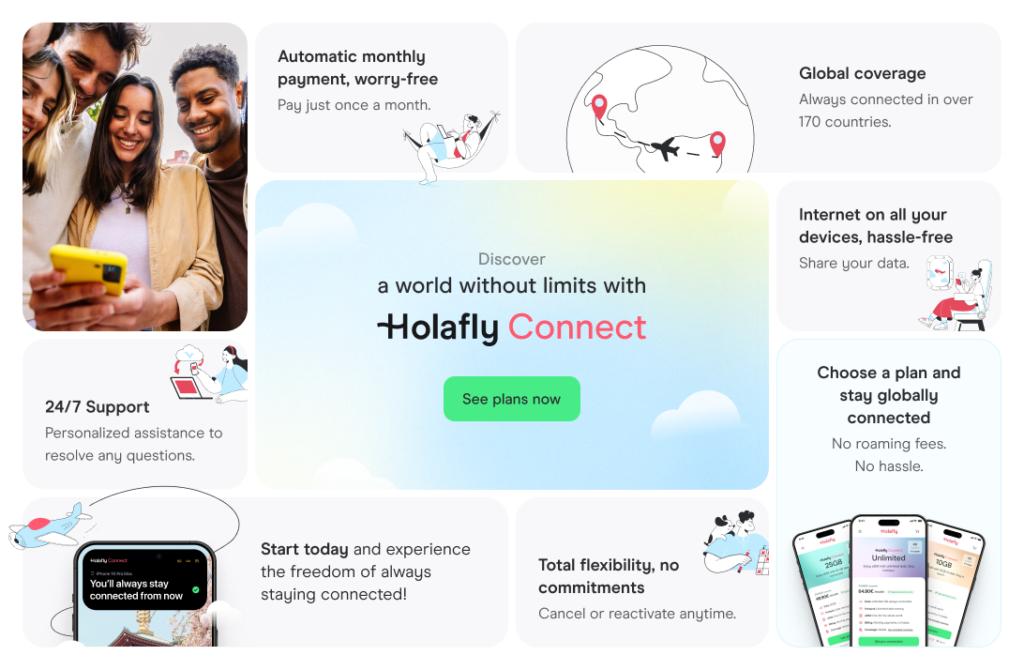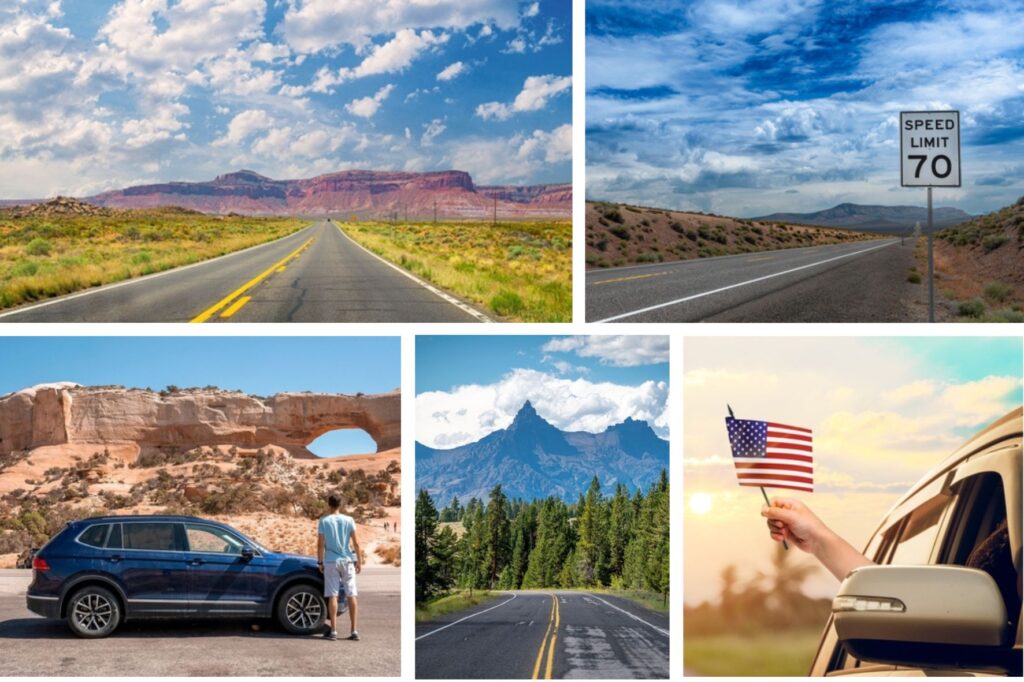Driving in USA: Learn all the requirements
Get familiar with driving in the USA so you can hit the road with confidence and turn your trip into a full-on adventure worth remembering.
Ever dreamed of driving along the iconic Route 66 or exploring the West Coast by car? Road trips in the U.S. are truly unforgettable adventures. Every year, countless travelers hit the road to discover America’s cities and stunning natural landscapes. If that sounds like your kind of travel, our guide to driving in the USA will help you plan that dream road trip the right way.
Fun fact: the USA has more highways than any other country in the world. Just the interstate system alone stretches over 78,000 kilometers, connecting nearly every state. Pretty amazing, right? Given the country’s massive size, it makes sense to have such a vast, reliable, and well-maintained road network.
Picking up where we left off—today’s guide covers everything you need to know about driving in the USA as a foreign visitor. From valid license types and when you’ll need an international permit, to getting the right insurance and understanding key traffic rules. We’ve also included helpful tips and answers to the most frequently asked questions to make your trip as smooth as possible.
Valid licenses for driving in the USA
Before you start mapping out your route and planning your adventure, it’s important to get the legal stuff sorted. Getting fined for not having the right license can really ruin your trip. So, your first step should be figuring out what kind of license you’ll need to drive in the USA. Keep in mind that not all foreign licenses are accepted the same way—some may require additional documentation or official translations.
Foreign driver’s license
If you’re coming from a Latin American country—like Mexico, Argentina, Chile, or Colombia—or from Spain, you’re in luck. You can use your local driver’s license to drive in the USA for up to three months, as long as it’s valid and legible. So before your trip, make sure your license hasn’t expired or isn’t about to.
That said, keep in mind that some states have their own rules. For example, places like Georgia, Massachusetts, or Florida may require an official translation of your license or an additional document. So once you know which states you’ll be driving through, it’s a good idea to double-check if there are any specific requirements for your license.
International Driving Permit (IPC)
The International Driving Permit (IDP) is often required for foreign drivers in many countries. It basically serves as a translation of your local license into multiple languages, making it easier for authorities abroad to recognize it. Just keep in mind—the IDP doesn’t replace your original license, so you’ll need to carry both while driving.
In the case of the United States, it is not mandatory in all states, but it is still recommended to have the IPC if:
- Your license is in a language other than English.
- You plan to rent a vehicle (most agencies require it).
- You are traveling from a country whose license is not always directly accepted.
Getting an IDP varies slightly from country to country, but the process is usually quick and done in person. You’ll typically need a valid driver’s license, a passport-size photo, and to pay a small fee. For example, in Mexico you can get it through the National Automotive Association (ANA), while in Argentina it’s issued at any branch of the Argentine Automobile Club (ACA).
When is an IDP not required? Travelers from the UK, Canada, and Australia can drive in the USA using their own driver’s license without needing an IDP.
Can the license be exchanged?
The USA doesn’t have agreements for exchanging driver’s licenses with other countries. So, if you’re staying for more than three months or have a work or study visa, you’ll need to get a local driver’s license from the state where you live.
Local driver’s license (for long stays)
As you know, in many cases your national driver’s license is valid for driving in the USA for up to three months. However, if you plan to stay longer—whether you have a work or study visa or are seeking residency—you’ll need to apply for a local driver’s license in the state where you’re living. While the process can vary from state to state, generally, you’ll need to:
- Provide your visa or residency permit
- Have proof of U.S. residency
- Pass a theoretical and a practical exam
- Pay the corresponding fee
With a little luck (and if you have a valid license from your country) you will be exempt from having to take a practical exam.
Requirements and documentation to drive in the United States
Now that you know about the valid licenses for driving in the USA, it’s important to remember that having the right license is just one of the requirements. For example, having insurance, not driving under the influence of alcohol, and meeting the minimum age requirement are just as important as having a valid license. So, take note of the following rules (and keep in mind that they may vary slightly from state to state).
What is the minimum driving age in the USA?
While each state sets its own minimum driving age, in most cases, you can get a license at 16. However, if you’re planning to rent a car (and you’re a foreigner), you’ll need to be at least 21. This is a standard requirement for most rental agencies. Some even charge an extra fee for drivers under 25.
There’s no official maximum age for driving in the USA, but as you might expect, it’s important that drivers are able to maintain their physical and mental abilities to safely operate a vehicle.
Can people with disabilities drive in the United States?
In general, people with disabilities can drive in the USA as long as they have a valid license and the vehicle is equipped with adaptations to meet their needs. They must also carry a disabled parking permit to take advantage of those spaces.
Mandatory vehicle insurance
If you’re driving in the USA, whether in your own car or a rental, make sure you have liability insurance. Check that the policy meets the minimum requirements for the state you’re in.
What about renting a car? Rental companies typically include basic insurance in the price, but they’ll also offer extra coverage. Before you sign anything, carefully review the policy to make sure it covers everything (especially the fine print!).
Technical inspection of the vehicle
All vehicles registered in the U.S. are required to undergo regular inspections. However, if you’re renting a car, you won’t need to worry about this, as rental agencies provide vehicles with all the necessary paperwork up to date.
Allowed alcohol level
Like most countries, the U.S. has a legal blood alcohol limit for driving. It’s set at 0.08% for drivers over 21, while anyone under that age is not allowed any alcohol in their system. So if you’re drinking, it’s best not to drive—take an Uber, a taxi, or have someone else drive you instead.
Environmental labeling
The U.S. doesn’t require a specific environmental sticker to drive, but some cities (like New York or Los Angeles) encourage the use of electric or hybrid vehicles. If you’re renting a car or just passing through on your way to another country, there are no restrictions in place.
Stay connected while driving in the USA
Having internet access at all times will make your road trip across the U.S. much easier. Whether it’s for using GPS, checking directions, monitoring traffic, or getting help in case of an emergency, staying connected on the road is essential.
With Holafly Connect, you’ll get unlimited data in the U.S. and over 170 other countries. Plus, you can share your internet with everyone in the car, making it perfect for family or group trips. Best of all, there’s no need to change your SIM card, no contracts, and instant activation.
Important: If you are a frequent traveler and want to stay connected without worrying about expensive roaming or looking for a new SIM at every destination, Holafly’s subscription plans are for you. With a single eSIM, enjoy internet in more than 170 countries for a fixed price and no surprises on your bill. travel without limits and connect easily and securely! 🚀🌍

Traffic regulations and signaling in the United States
If it’s your first time driving in the USA, it’s important to review the main traffic rules and signs. This way, you’ll have the basic knowledge you need to avoid fines or issues on the road. While many rules are similar to those in other countries, there are some specific ones that might surprise you.
Priorities and traffic direction
Let’s go over some basic rules regarding right of way and traffic flow. In the U.S., cars drive on the right side of the road (like in most countries), and the steering wheel is on the left. At intersections without traffic lights, the rule is ‘first to stop, first to go.’ This means that no matter where you’re coming from, if you’re the first to stop, you get to go. In roundabouts, vehicles already inside have the right of way.
Speed limits
Getting a speeding ticket can cost you a lot more than you planned, taking money away from other things. So, it’s important to follow the speed limits. The tricky part is that these limits differ by state and type of road, but here are some general guidelines to keep in mind (shown in miles per hour, not kilometers):
| Type of road | Maximum limit |
| In urban areas | Between 25 and 35 mph (40 to 56 km/h) |
| On rural highways | Between 55 and 65 mph (88 to 105 km/h) |
| On interstate highways | Between 65 and 75 mph (105 to 120 km/h) |
Cell phone use
Wherever you are, using your phone while driving is never a good idea. In most places across the U.S., it’s illegal to handle your phone without hands-free options. Even just holding it can get you a fine. To avoid this, use a phone mount or Bluetooth system.
Belt and lights
If you’ve ever watched American movies, you’ve probably noticed that characters always put on their seatbelts, even if they’re just driving a short distance. This is because it’s a basic traffic rule that’s enforced in every state: anyone getting into a vehicle must wear a seatbelt, no matter which seat they’re in.
Regarding lights, some states require lights to be on during the day on highways or in low visibility conditions.
Emergency kit
Picture this: you’re on the road, and you get a flat tire, or your car battery dies because you left the lights on. It can happen, which is why it’s important to have an emergency kit with essentials like a safety triangle, flashlight, jumper cables, and a first aid kit. If you’re renting a car, it probably comes with everything you need, but it’s always good to double-check.
Traffic signs
Familiarizing yourself with traffic signs is another important step before you start driving in the USA. While the signs are clear, they can be quite different from those in many other countries.
For example, many signs are worded ‘STOP’ or ‘SCHOOL ZONE. Some specific signs might say things like ‘No U-turn’ or ‘Yield.’ As for colors, yellow means caution, red signals a mandatory stop, and green indicates you’re clear to go.
Fines and penalties for infractions
As a driver, getting a ticket is always frustrating, especially if it’s because you weren’t aware of the rules or were distracted. In the U.S., where traffic fines can be pretty harsh, especially for foreigners, it’s best to avoid giving officers any reason to pull you over.
What are the most common penalties that foreigners face when driving in the United States?
- Speeding: This is one of the most common. Fines range from $50 to over $500, depending on the state and extent of the speeding.
- Using a cell phone while driving: Another common mistake we make when getting into a vehicle is this. Fines for this can start at $100 and go up from there.
- Not respecting a stop sign or red light: This mistake can cost you anywhere between $150 and $300. Keep in mind that if there are cameras, it doesn’t matter if there’s no police officer around to issue the ticket at the moment – sooner or later, the fine will find its way to your accommodation.
- Driving under the influence of alcohol: As we mentioned earlier, this is a serious offense that could lead to jail time, visa cancellation, or even deportation. On top of that, you’ll face a hefty fine.
Most (if not all) of these infractions are avoidable. You only need to be responsible behind the wheel.

Tolls and refueling in the United States
Now, let’s go over some important things you need to know about tolls and fuel if you’re planning to drive in the U.S. While traveling by car across the country is comfortable and safe, there are some logistical details worth understanding before hitting the road. Tolls and fuel are part of the journey, and knowing how they work will help you save both time and money.
How do tolls work in the United States?
Not all highways in the USA have tolls, but they’re quite common in many states, especially along the East Coast. Toll roads, as they’re called, charge fees that vary depending on the route, state, and type of vehicle.
The average toll for passenger cars ranges from $1 to $15, though on longer stretches or specific bridges, it can exceed $20. For example, the toll for crossing the George Washington Bridge in New York City is around $17, while crossing the iconic Golden Gate Bridge in San Francisco costs about $9
Toll payment methods
In most tolls across the country, you can pay with cash, credit or debit cards (although not always), or through Electronic Toll Systems (ETC) like E-ZPass, SunPass, or FasTrak. This method is the quickest and most convenient, as it lets you pay automatically without having to stop.
Price and types of fuel in the United States
Let’s move on to the next lesson in this U.S. driving guide: fuel. It’s sold by the gallon (1 gallon = 3.78 liters), and the most common types are:
- Regular (87 octane): It is the most economical and the one used by most rental cars.
- Mid-grade (89 octane): It is a little more expensive than the previous one, generally suitable for vehicles with higher compression.
- Premium (91-93 octane): Recommended for high-end or sports vehicles.
- Diesel: It is the least common type of fuel in private cars, but more frequent in trucks or large vehicles.
Fuel prices in the United States
Fuel prices in the U.S. can vary quite a bit from state to state. However, you can use these average prices as a reference when planning your road trip budget:
| Type of fuel | Price |
| Regular | Between $3.20-3.80 per gallon |
| Premium | Between $4-4.80 per gallon |
| Diesel | Between $4-5 per gallon |
Converted to liters, the price of fuel is around $0.85-1.25 per liter, depending on the type and region.
How to fill up with fuel?
Once again, if you’ve watched Hollywood movies and TV shows, you’ve likely noticed that in the U.S., it’s the drivers who pump their own gas.
Don’t worry, the process is really simple. Just pull up to the pump, choose the type of fuel you need, and then pay with a credit card (or cash inside the store). Next, grab the nozzle and start filling up. Wait for your receipt, and you’re all set. It might feel a bit nerve-wracking the first time, but after driving a few miles, you’ll quickly get used to this self-service method.
Another important tip is to always carry some cash with you, especially if you have to refuel in rural or isolated areas.
Parking in the United States
We’re nearing the end of this driving in the USA masterclass. Before we finish, we need to cover something essential: knowing where and how to park. While parking rules can vary across cities and states, there are some general tips that will help you avoid fines. Here are a few to keep in mind:
Where can you park?
In most public streets, you can park as long as there are no signs prohibiting it. Make sure to check both the signs and the curb markings, as many are painted with color codes that indicate whether you can park there or not.
- Red curbs: No parking.
- Yellow curbs: For loading and unloading only.
- White curbs: For passenger loading and unloading.
- Green curbs: Permitted for a limited time.
- Blue curbs: Exclusive for people with disabilities.
Pay attention, as there are often signs with specific hours. For example, a sign might say you can park Monday to Friday until 4:00 PM, but not during rush hours.
Public and private parking lots
If you’d rather avoid any risks, you can choose private parking lots or garages. These are available in city centers, airports, train stations, and tourist areas.
- Parking meters: Average price between $1-4 per hour, depending on the city.
- Private parking lots: From $5 per hour, and between $15-40 per full day. In areas such as Manhattan, Chicago or San Francisco, prices can exceed $50 per day.
- Weekly parking rental (in private garages or apps): Between $80-200 per week, depending on location.
A helpful tip for big cities is to use apps like SpotHero or ParkWhiz to compare prices, reserve a spot, and avoid unnecessary driving around.
In which places or zones is parking prohibited?
As in every city and town around the world, there are areas where parking is not allowed. Do you know which ones? Let’s go over them:
- On ramps for the disabled.
- In front of fire hydrants.
- At garage entrances or emergency exits.
- In school zones during school hours.
- At bus or cab stops.
- Double-parked or blocking another vehicle.
Parking restrictions are pretty similar to those in most countries. Just stay mindful and you can avoid fines anywhere from $35 to $150—or even having your car towed.

Rental car options in the United States
Most foreign travelers who come to the USA with the idea of taking a road trip usually rent a vehicle (unless you’re traveling in your own car). Keep in mind that since road trips are so popular here, the country is well-equipped to welcome travelers from all over the world, and you’ll find rental agencies just about everywhere.
When renting a car in the USA, the options can vary significantly between agencies. However, most foreign tourists tend to go for compact and affordable cars, as they’re easier to handle. For longer trips or challenging terrains, 4×4 vehicles or SUVs are a better fit since they provide more space for luggage and passengers. Minivans are also a popular choice, especially for families or groups larger than four. The right choice will depend on your travel plans, the roads you’ll be taking, and how many people are with you.
How much does it cost to rent a car?
When planning your budget, the cost of renting a car will be one of the key factors. Rental prices can fluctuate based on the vehicle type, how long you need it, the state you’re in, and the time of year. That said, here are some average prices to help you estimate your expenses:
- Daily rental: From $30 for compact cars to $70 for SUVs or minivans.
- Weekly rental: Between $200-450, depending on model and agency.
- Monthly rental: From $800 for basic vehicles, although it can exceed $1,200 in cities with high demand.
Before signing the contract, check if insurance, automatic tolls and taxes are included in the price.
10 final tips for driving in the USA
As you can see, driving in the USA can be quite straightforward if you’re aware of the key details and have a basic understanding of the traffic laws. So, to wrap up, here are 10 useful tips to ensure your driving experience is safe, legal, and stress-free.
- Seriously, stick to the speed limits! As you already know, speed limits are strictly enforced, even in rural areas. Speed cameras are everywhere, and the police are ready to pull you over if you’re even slightly over the limit.
- Always wear your seat belt. Mandatory for all vehicle occupants, regardless of whether they are in the front or back seats.
- Do not drink alcohol if you are going to drive. The USA has a low tolerance for drinking and driving. If your blood alcohol level exceeds 0.08%, you could face hefty fines, license suspension, or even arrest.
- Avoid using your cell phone while driving. We all know that our phones have practically become a part of us. But when you’re behind the wheel, put it down and use hands-free. It’ll help you avoid fines and keep your attention where it belongs—on the road.
- Be patient at roundabouts. In the big cities across the U.S., roundabouts can often feel like a never-ending flow of cars. Remember, vehicles already in the roundabout have the right of way. So take a deep breath and relax!
- Plan your routes in advance. The best part of a road trip is planning your route. Remember, the United States is huge, and the distances can be really long. Make sure you do some basic planning before setting out. Apps like Google Maps or Waze can help you avoid tolls, track traffic, or locate gas stations on your journey.
- Avoid driving during rush hours. Try to avoid driving during rush hour, especially in larger cities. It’s often better to park and walk around—you’ll get to enjoy the surroundings a lot more!
- Always have your documents handy. Don’t hit the road without your driver’s license, passport (just in case), rental car agreement (if applicable), and insurance policy. Traffic officers may ask for them at any time.
- Get familiar with the local traffic signs. While many road signs are universal, take a quick review of them and become a traffic pro in the U.S.
- Be patient and respectful. If you’ve driven in places like Southeast Asia, you’ll find that driving in the USA is generally more orderly. So, just follow the rules, respect the signs, and drive like a local.
Frequently asked questions about driving in the USA
Yes, you can use it as long as it’s valid and written in the Latin alphabet. However, if you plan on renting a car or visiting multiple states, it’s a good idea to also carry an International Driving Permit.
First of all, stay calm. It’s natural to feel nervous in those situations, but stay composed. Keep your hands on the wheel, roll down your window, and wait for instructions. If they ask for documents, hand them over without arguing, and don’t get out of the car unless instructed to.
Yes, in most cases, your national driver’s license will allow you to drive on U.S. roads for up to three months. If you plan to stay longer, you’ll need to get a local license.
If you’re involved in an accident, even a minor one, call 911 right away. Make sure to exchange details with the other party (if there is one) and take pictures of any damage. If you’re driving a rental car, inform the rental company as well.





 Language
Language 


















 No results found
No results found



